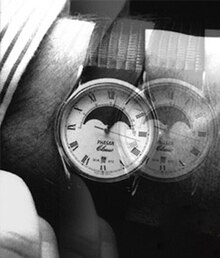Diplopia
| Classification according to ICD-10 | |
|---|---|
| H53.2 | Diplopia |
| ICD-10 online (WHO version 2019) | |
Diplopia ( synonyms: double vision, double vision ) is usually a disorder of binocular vision that results in the perception of identical objects in different places in space. It is in a squinting eye caused by the projection of visual things on the retina, which have a different room location to those on which the object was displayed at the non-squinting eye. Depending on which eye muscles are affected, the position of double images can be horizontal, vertical or tilted. In addition, their distance can vary greatly depending on the viewing direction.
Diplopia can be associated with the following clinical pictures, which have an ocular muscle imbalance disorder as a central symptom :
- Lesions of the cranial nerves responsible for the motor supply of the eye muscles ( paralysis strabismus ): Nervus oculomotorius , nervus abducens or nervus trochlearis
- Disturbance of the neuromuscular transmission of stimuli as in myasthenia gravis pseudoparalytica or some poisoning ( botulism )
- mechanical restrictions in the area of the orbit (e.g. orbital floor fracture , Brown syndrome or space-occupying processes)
- inflammatory processes such as endocrine orbitopathy
- early childhood squint
- normosensory late squint
- decompensating heterophorias .
Another form of diplopia that has no pathological background is called physiological diplopia . This occurs when objects projected onto the retina are outside the limits of the so-called panumareal .
Double images can be corrected optically with prisms in certain cases and depending on the findings , but this does not deal with the triggering causes. Conversely, this means that double images can also be triggered by prisms.
Monocular diplopia
If diplopia is perceived with only one eye ( monocular diplopia ), changes in the cornea such as keratoconus , cataracts or other lesions in the refractive media may be the reason for this. In very rare cases, monocular diplopia can also be the undesirable result of intensive, pleoptic amblyopia treatment . Monocular double images can also arise if the eye shows aberrations of a higher order such as clover leaf, coma or spherical aberration. Such aberrations can often be corrected with appropriate glasses .
- Cerebral polyopy
A very rare form of monocular diplopia is its perception with both eyes, i.e. alternately with the right and left eye, depending on which is currently open ( cerebral polyopia ). In addition to psychosomatic aspects, this can be triggered by organic disorders in the form of acquired lesions in the visual cortex .
See also
Web links
literature
- Herbert Kaufmann (Ed.): Strabismus. With the collaboration of Wilfried de Decker et al., Enke, Stuttgart 1986, ISBN 3-432-95391-7 .
- Albert J. Augustin: Ophthalmology . Berlin: Springer Verlag, 2007, p. 152 ff. ISBN 978-3-540-30454-8
